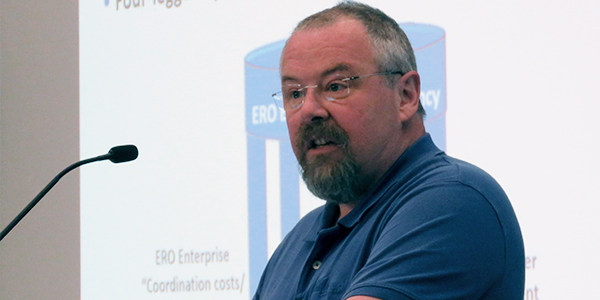By Rich Heidorn Jr.
ORLANDO, Fla. — NERC is likely to merge its Planning, Operating and Critical Infrastructure Protection committees into a single “Reliability Council,” committee members learned last week.
NERC announced in May that a Stakeholder Engagement Team (SET) was reviewing the ERO’s structure after 10 years of operations. The organization said it was considering two options: retaining the three committees while adding an Oversight Committee to coordinate their work, or merging them into a new Reliability Council reporting to the Board of Trustees. (See “Potential Change to Committee Structure,” NERC MRC, Trustees Meeting Briefs: May 8-9, 2019.)
“Right now, Option 2 is the one that’s getting the most traction within the group,” outgoing OC Chair Lloyd Linke told attendees of a joint OC/PC/CIPC meeting June 4. “And so, we have a small group that is reviewing the participation models from the various existing functions.”
Linke said the proposed change is a response to complaints that the three technical committees were inefficient given the increasing “blurring of the siloes.”
“The Member Representatives Committee and the NERC board was receiving input from executives in the industry that the current structure was too expensive; too much manpower was being spent in supporting the technical committees,” Linke said. “And they wanted NERC to take a hard look at that and see if there was any way that the technical comms could become more efficient.”
Linke also said the change is a recognition that NERC has been increasingly using cross-disciplinary task forces to address emerging issues, such as those on essential reliability services and inverter-based resources.
“The executives in the industry and the board have seen that working really well and want to make sure we maintain an agile process where we can continue to meet emerging issues,” he said.
The stakeholder engagement team — which includes Chief Reliability Officer Mark Lauby, Trustees Ken DeFontes and Fred Gorbet, and MRC Chair Greg Ford — is considering a 22-member Reliability Council with a hybrid structure: a single representative from each of the 11 sectors excluding regional entities and an equal number of at-large members selected based on a diversity of skills and geography, Linke said.
“There was a strong feeling that the regional entities are part of the ERO, and this being a stakeholder representative [group], there didn’t need to be regional entity participation,” he explained. “Most of the regional entities participate in these meetings as guests anyway, so that would still continue.”
The Reliability Council’s meetings would offer listen-only web access, Linke said. “So, I would still expect for those who wanted to actively participate to physically attend the meeting.”
Linke acknowledged the smaller committee would have to look beyond its membership to find subject matter experts for future task forces. “It will be a little more difficult, but I think it’s still manageable,” he said.
The current schedule calls for seeking MRC endorsement in August and delivering a final proposal to the board in November. The new structure would be effective Jan. 1, 2020, and be implemented for the March meetings, Linke said.
There are no current plans to change the structures of the subcommittees, task forces and working groups, but there would be a review after one year to determine if other changes should be considered, Linke said. “Right now, I don’t see charter changes to the subcommittees. Whether there may be in the future, I’d hate to hazard a guess.”
The current two half-day meetings for each committee would probably expand to a day-and-a-half or two days and would mostly take place at NERC offices, Linke said.
“What you would lose was some of the some of the industry presentations on lessons learned. … It would evolve down to … strictly a business meeting — report on what the subcommittees are doing, the task forces; providing whatever oversight and guidance may be needed and not a lot of the extra things,” he said.
Linke said the training and security briefings the CIPC has included in its meetings “could be on the front-end or back-end of some of these meetings or maybe the E-ISAC [Electricity Information Sharing and Analysis Center] will have to pick up a role.”
CIPC Chair Marc Child urged members to provide feedback on the proposal. “I’m a member of the Stakeholder Engagement Team myself, and I still have a thousand questions about how this is all going to work,” said Child, of Great River Energy. “The CIPC … [has] relationships with the E-ISAC we have to make sure that we maintain: entity direct access to National Lab partners and other federal partners.
“Work through your [trade groups], work through your other stakeholder organizations [to communicate] things that you like about the current model; things that you don’t like about the current model; things that you wish were happening,” Child continued. “Make sure your voice is heard.”
Linke said the board will accept input through the MRC sector representatives. “It will be probably be a consensus of the sectors as to what that policy input [to the board] will be,” he said.





